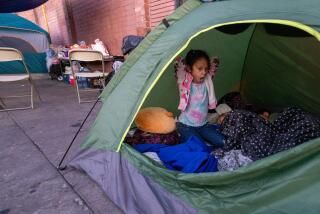Family’s Heart, Home Open to Orphans : 7 Were Not Enough, 9 May Not Be Either
TORRANCE — Why would parents with seven children adopt two more and consider adopting another?
“We just always wanted to adopt, especially Chicano kids,” said South Bay Municipal Judge Benjamin Aranda III.
Aranda and his wife, Emma, a chemist with the U.S. Food and Drug Administration in Los Angeles, took in two siblings--Carlos, 9, and Tania, 6--nearly two years ago after having seven of their own.
“We were going to adopt four siblings, but when our papers were processed, the children were not free from the court,” Aranda said.
The Arandas were one of 15 families last Friday who were to receive final adoption decrees in a ceremony at Los Angeles Superior Court.
They may be back in court soon for a repeat performance. A few months ago, at an awards ceremony at the Los Angeles County Department of Children’s Services adoptions division, the Arandas saw other children who needed to be adopted. So they have begun the paper work to add child No. 10.
“One more kid isn’t going to make much difference,” said Maria Cristina, 17, the Aranda’s second-oldest child, as five of her brothers and sisters chattered in the cluttered family room of their west Torrance home. The other children are Rebecca, 19, who is away at college in Utah; Ruth, 15; Benjamin IV, 14; Andrea, 12; Danielle, 9, and David, 8.
Arlene Perez, a county child welfare worker assigned to the Arandas, said they represent a small but growing number of parents willing to adopt minority siblings over the age of 3. Perez said it is difficult to place such children, as well as children with disabilities. Tania was born with only half her left arm and wears a prosthesis. Carlos was classified as having problems in school.
Perez said it also is uncommon for a couple with a large family to adopt more than one child.
“In my experience it is unusual, but if you see the way they work with the kids, the time they spend with them, then you’d see how natural it is for them to have a lot of kids,” she said.
Even though they admit that friends think they are crazy, the Arandas said adopting--which was a decision made by the entire family--was not difficult.
“It’s very satisfying for us,” he said. “Plus, I just couldn’t see some poor kid being without a real home if we could do it. You’re supposed to come into this world and try to make it a little bit better before you leave. Well, we’ll show that with nine little people. Maybe 10 little people.”
Aranda, 45, said one of the reasons he accepted a judgeship nearly seven years ago--at an annual pay cut of $20,000--was to make his nights and weekends free to spend with his children.
When he was a corporate attorney for 10 years, he said, he was home only two nights a week. On those nights he taught Roman Catholic religion classes for eighth graders at his home, something he has been doing for the last 31 years.
Aranda credits his Mexican heritage and his religious convictions for feeling comfortable with such a large family.
“In the Mexican culture you have large, close-knit families who are also close to the church,” said Aranda, who is one of five children. His wife is from a family of six children. “We wanted to help other Chicano kids who didn’t have a chance. If (Chicanos) don’t adopt them, who’s going to adopt them?
“And since my wife works for the Food and Drug Administration, she saw all the problems with the (birth control) pill, and since we’re good Catholics, we said, ‘No, we can’t do it anyway.’
“So all our kids are basically rhythm babies,” he said, referring to the natural birth control method that attempts to predict ovulation and is acceptable to Catholic leaders.
Despite lofty careers, the Arandas combined income is just enough to cover the expenses of caring for nine children, the couple said. Emma Aranda, 46, had taken seven years off to rear the children, but when he became a judge, she had to return to work part time.
Aranda says they spend $400 a week in groceries and daily lunch money. The family goes through a gallon of milk, two loaves of bread and two boxes of cereal a day. Twice a month, two new pairs of shoes are needed, especially soccer and basketball shoes.
Monthly tuition for Catholic school for five of the nine children is $280. College tuition and expenses for the oldest daughter comes out to about $600 a month.
“We will probably never own a new car, probably never go to Europe, but going to soccer games and going to Little League games to watch our children is worth more than that to us,” Aranda said.
“It’s a matter of priorities and values,” Emma Aranda said. As for cars or vacations, she said, “Those things never appealed to me.”
The Arandas live in a five-bedroom, three-bath home, but it is modest and the furniture is basic.
Emma Aranda leaves for work at 6 a.m., and the judge’s morning routine includes tossing a load of clothes into the washer before leaving for work. When his wife comes home, she put those clothes in the dryer and dumps another load into the washer. He said they average about 30 loads a week
“We could probably give an endorsement for whoever makes that washing machine,” he said.
The routine makes the workday easier, not harder, said Aranda, who is the South Bay Municipal Court’s presiding civil judge and assigns cases to other judges.
“After having gotten together 16 matching socks, 16 shoes, 8 backpacks and having made breakfast and preparing lunches for all of them, by the time I get to court everything else seems peaceful,” he said.
Aranda said the children sometimes fight.
“There are times when one kid will say, ‘I wish we didn’t adopt you,’ but then the other will turn around and say, ‘I wish you weren’t born,’ ” he said.
But the only real problem as parents of such a large family, he said, is finding enough time for each child.
“You want to make each one feel as though you are there just for them,” he said. “I want each one of my kids to believe that I love them the best. Because I do.”
More to Read
Sign up for Essential California
The most important California stories and recommendations in your inbox every morning.
You may occasionally receive promotional content from the Los Angeles Times.










